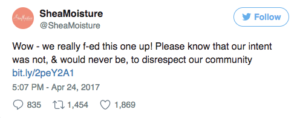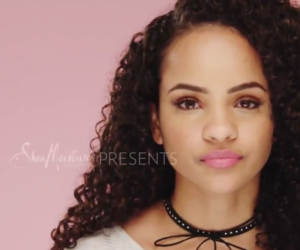Shea Moisture: The Importance of Knowing Your Audience
In April of 2017, the hair product company Shea Moisture released the following ad:
It seems like a normal commercial, right?
You might be surprised to discover that this ad was extremely controversial. In fact, it caused such an uproar that Shea Moisture immediately pulled it and issued this apology:

So, what went wrong?
Why Shea Moisture Failed
The uproar behind this ad can be blamed on a disconnect between market research and advertisement creation–Shea Moisture didn’t consider its customer demographics. A vast majority of its customers are women of color, a segment which is largely ignored by mainstream beauty brands. Shea Moisture was a favorite among this group not only because it specifically marketed to them (unlike most other beauty products) but also because it was created by a black family.
According to founder Richelieu Dennis, the goal of the campaign was not to exclude their customer base but to bring light to all women’s hair challenges in order to grow the business. Dennis said of the company: “The competition that we now see puts businesses like ours at risk.”
However, while the purpose of the commercial was to expand the company’s market reach, the audience took it as an abandonment of Shea Moisture’s loyal black customer base. To them, the company they had helped build up was turning its back in favor of attracting white customers, who already had plenty of products marketed to them.

Colorism and Natural Hair Prejudice
Another reason for the backlash against Shea Moisture was because it didn’t clearly understand the continual bias its customers face. Besides a lack of marketed beauty products, the black community also faces colorism–a discrimination within the demographic for lighter skin colors over darker ones–as well as prejudices against natural hair. Shea Moisture’s attempt to represent its customer base with the lighter-skinned, shiny-haired model failed to resonate. Further insulting was comparing red-haired, white women’s hair stereotypes (which are mostly limited to jokes about gingers) to the real prejudices black women with natural hair face in school and the workforce, where their hair type is frequently banned.
What Could Shea Moisture Have Done Instead?
Sometimes, a company needs to expand its market to remain profitable. However, when attempting to grow, it’s important that companies don’t forget their current customers and what these customers value about their brands. That was Shea Moisture’s mistake. Instead, Shea Moisture could have made a commercial that described how its products worked on all types of hair, which would include white women without excluding women of color. The commercial should have featured more black women with natural hair, and it should have avoided trivializing hair prejudices black women face.
How You Can Learn From Shea Moisture
The key to avoiding the controversy Shea Moisture faced is to know your audience and know them well. Pay attention to who is buying your products, and then go further–what is it like to be a member of this group? What issues are they facing, what needs do they have? If you really understand your customers, you will be able to better market to them.
Again, expanding your market isn’t bad, but you have to find that balance between growth and loyalty to your current market. The bottom line is this: Don’t lose your 90 percent in pursuit of the 10 percent. Don’t risk your strong share of one market on the chance of grabbing hold of a weak share of another. Care makes all the difference between a successful expansion and a controversial failure!
How EnVeritas Group Can Help You
In this blog, diversity marketing may sound simple, but the reality is that it can be incredibly complex. That’s where EnVeritas Group can help. Not only do we have the experience to guide your diversity marketing in the right direction, but we also have a global staff with a myriad of language skills and cultural backgrounds. This allows EVG to communicate with people around the world in their own language and with respect to their own culture. It helps them know their audience. We can help you know yours too.
Inquire online today to find out how EVG can help you speak directly to your audience and more successfully market to diversity.
Annie Sanford – Content Creator



